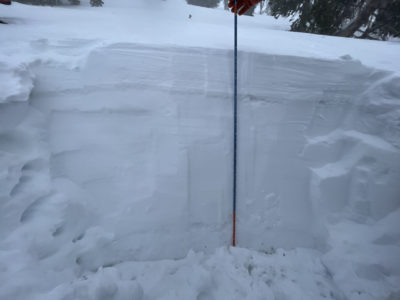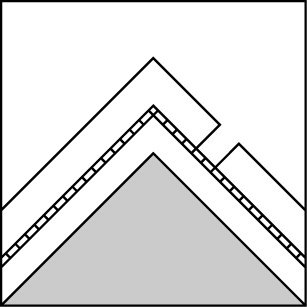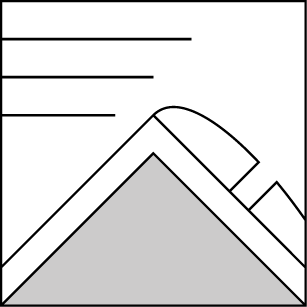Basic Information
Observation Details
Observation Date:
December 27, 2022Submitted:
December 27, 2022Observer:
SAC - Davis, CobaZone or Region:
Galena Summit and Eastern MtnsLocation:
Titus Ridge (All aspects, 8,700-9,900)Signs of Unstable Snow
Recent Avalanches?
YesCracking?
IsolatedCollapsing?
IsolatedSnow Stability
Stability Rating:
FairConfidence in Rating:
ModerateStability Trend:
WorseningBottom Line
We observed intense wind-loading along Titus Ridge that formed slabs up to 2' thick. Wind-loaded terrain was obviously dangerous. It snowed steadily all day. The snow was generally heavy and rimed, which formed a thin but dense storm slab in sheltered locations by the end of the day. The storm snow was not touchy except on steep features drifted by wind.
Advanced Information
Weather Summary
Cloud Cover:
OvercastTemperature:
25-30FWind:
Strong , SWNew/Recent Snowfall:
HST = 25-30 cm
Today's storm was one of the rowdier storms I've been out in for some time. I was knocked off balance by ~60mph gusts and we were sandblasted along exposed ridge lines. Intense wind loading was occurring on many slopes. Storm totals were in the ballpark of 25 cm.
We were never rained on, but there was obvious wet snow and rain effect (no snow in trees, stains below from meltwater) beginning around Prairie Ck (7,000') and south.
Avalanche Observations
| # | Date | Location | Size | Type | Bed Sfc | Depth | Trigger | Comments | Photo |
|---|---|---|---|---|---|---|---|---|---|
| 10 |
Steep rocks along Highway 75 from Hulen Meadows to Lake Ck W 6400 |
D1 | WL | N-Natural | None | ||||
| 6 |
Along Highway 75 across from Gimlet Rd E 6700 |
D1.5 | WL | N-Natural | None |
All observed slides were wet loose below the rain line around Highway 75.
Snowpack Observations
NW @ 9,100' HS=145 cm, HST=20 cm: This planar, sheltered slope was protected from the wind. "New/old" ECTNs <5 hits. There was a weak melt-freeze at this interface. "12/19" ECTNs (18,19) dn 35 cm. "12/8" ECTXs dn 50 cm. No propagation with additional hits. "11/27" ECTXs dn 110 cm. No propagation with additional hits. CPST35/100 end. Slab above the layer was very strong (1F+). The weak layer had a 5 cm interval of dry 4F facets. Below that the facets near the ground were moist and rounding.
SE @ 9,700' HS=133 cm: This planar slope was wind-affected. Sometimes loaded and sometimes scoured by swirling wind ~200' below the ridge. This was a quick pit since we were in a low-grade hurricane. "New/old" ECTN17 dn 25 cm on a stout (P+) 4 cm melt-freeze crust. Meltwater channels extended ~20 cm below the crust. Midpack weak layers were not reliably located and did not reveal themselves in tests. "11/27" dn 110 cm presented as rounding facets. Dry in the upper third and moist closer to the ground. ECTX including several extra-hard hits.

Avalanche Problems
| Problem | Location | Distribution | Sensitivity | Size | Comments |
|---|---|---|---|---|---|
 Persistent Slab
Persistent Slab
|
|
Layer Depth/Date: 100-120 cm Weak Layer(s): Nov 27, 2022 (FC) Comments: ECTXs. No propagation in either pit with additional thumps. CPST35/100 end on a NW-facing slope. |
|||
 Wind Slab
Wind Slab
|
|
Layer Depth/Date: 30-60 cm Comments: Much more likely at upper-elevations but I would guess they would be found in exposed areas at middle elevation too. Sensitivity was probably between stubborn and reactive. I would have bet that a medium sized cornice drop could release a wind slab. We stomped on some wind lips and cornices. They broke but not in an impressive manner. Both new/old interfaces we looked at (NW, SE) were not particularly spooky looking. This was only one ridge though, and I don't doubt there were sensitive wind slabs in the vicinity. |
Terrain Use
We wanted no part of wind-drifted terrain. Even sheltered terrain was much less appealing as the storm slab thickened near the end of the day.
